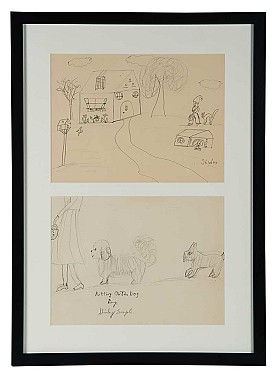Eight Mystery Dolls by Madame Alexander From Shirley Temple's Childhood Doll Collection
Lot #110
13" (33 cm.) Each of the eight dolls is all composition, having "Betty" face with pronounced cheek dimples, socket head, jointing at shoulders and hips, metal sleep eyes, painted features, little bow-shaped lips, luxury quality blonde mohair wig in various styles to accentuate the costume, and is unmarked. Generally excellent, very fresh and unplayed-with vibrancy, few minor age lines. The eight dolls are wearing original couturier-quality custom-made costumes depicting various themes: "Carmen" Spanish lady, Pierrette Folies Bergre girl, ballerina in maribou-trimmed silk costume, Dutch-costumed girl with attached long braids, girl in elaborate Eastern European folklore costume, girl in hula costume, Ziegfield Follies girl in sequin costume with maribou fan, and Japanese girl with silk costume, flowered headdress and carrying tiny paper mache doll. The actual dolls were made by Madame Alexander with use of the firm's "Betty" facial model, introduced in 1933, and used for one or two years only. It was at this time that the Alexander doll firm became heavily involved in seeking rights to make dolls representing child celebrities, and, although they did not have the license to make dolls in Shirley Temple's image, they did obtain the rights, from the heirs of Anne Fellows Johnston, to offer The Little Colonel doll, which was released in 1935 at the same time as the 1935 film. The doll was extremely successful and an eye-opener to the firm. Yet the background story of these particular eight dolls remains a mystery, Certain facts are without dispute. The dolls were gifted to five-year-old Shirley Temple as a set, as their appearance on an upper shelf in an early photograph of her doll room attests. (Appendix B). They were designed to resemble the young star, with pronounced dimples (rare to find on composition dolls by Alexander), sweet facial modeling, and blonde hair. Their costumes were made with fine fabrics and trims, identical to that found on other Alexander dolls of the era, as was the attention to fine workmanship and details. According to information related by Shirley Temple to her son and daughter, the dolls were sent to her in the early 1930s by the Madame Alexander doll firm, which having seen the success of The Little Colonel doll, likely aimed at receiving more commissions for dolls. In all, an outstanding ensemble of dolls, with wonderful provenance, and preserved in remarkable vibrant condition.
































































































































































































































































































































































































































































































